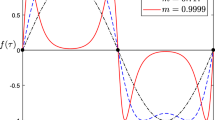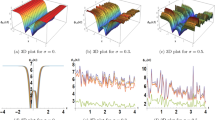Abstract
We study the asymptotic clustering (phase-locking) dynamics for the Kuramoto model. For the analysis of emergent asymptotic patterns in the Kuramoto flow, we introduce the pathwise critical coupling strength which yields a sharp transition from partial phase-locking to complete phase-locking, and provide nontrivial upper bounds for the pathwise critical coupling strength. Numerical simulations suggest that multi- and mono-clusters can emerge asymptotically in the Kuramoto flow depending on the relative magnitude of the coupling strength compared to the sizes of natural frequencies. However, theoretical and rigorous analysis for such phase-locking dynamics of the Kuramoto flow still lacks a complete understanding, although there were some recent progress on the complete synchronization of the Kuramoto model in a sufficiently large coupling strength regime (Dörfler and Bullo in SIAM J Appl Dyn Syst 10:1070–1099, 2011, Automatica 50:1539–1564, 2014; Ha et al. in Commun Math Sci 4:1073–1091, 2016). In this paper, we present sufficient frameworks for partial phase-locking of a majority ensemble and the complete phase-locking in terms of the initial phase configuration, coupling strength and natural frequencies. As a by-product of our analysis, we obtain nontrivial upper bounds for the pathwise critical coupling strength in terms of the diameter of natural frequencies, initial Kuramoto order parameter and the system size N. We also show that phase-locked states whose order parameters are less than \(N^{-\frac{1}{2}}\) are linearly unstable.
Similar content being viewed by others
Change history
27 August 2023
A Correction to this paper has been published: https://doi.org/10.1007/s00220-023-04820-8
References
Acebron, J.A., Bonilla, L.L., Pérez Vicente, C.J.P., Ritort, F., Spigler, R.: The Kuramoto model: a simple paradigm for synchronization phenomena. Rev. Mod. Phys. 77, 137–185 (2005)
Aeyels, D., Rogge, J.: Existence of partial entrainment and stability of phase-locking behavior of coupled oscillators. Prog. Theor. Phys. 112, 921–941 (2004)
Buck, J., Buck, E.: Biology of synchronous flashing of fireflies. Nature 211, 562 (1966)
Benedetto, D., Caglioti, E., Montemagno, U.: On the complete phase synchronization for the Kuramoto model in the mean-field limit. Commun. Math. Sci. 13, 1775–1786 (2015)
Bronski, J., Deville, L., Park, M.J.: Fully synchronous solutions and the synchronization phase transition for the finite-\(N\) Kuramoto model. Chaos 22, 033133 (2012)
Bonilla, L.L., Neu, J.C., Spigler, R.: Nonlinear stability of incoherence and collective synchronization in a population of coupled oscillators. J. Stat. Phys. 67, 313–330 (1992)
Balmforth, N.J., Sassi, R.: A shocking display of synchrony. Phys. D 143, 21–55 (2000)
Choi, Y.-P., Ha, S.-Y., Jung, S., Kim, Y.: Asymptotic formation and orbital stability of phase-locked states for the Kuramoto model. Phys. D 241, 735–754 (2012)
Choi, Y.-P., Ha, S.-Y., Kang, M.-M., Kang, M.: Exponential synchronization of finite-dimensional Kuramoto model at critical coupling strength. Commun. Math. Sci. 11, 385–401 (2013)
Chopra, N., Spong, M.W.: On exponential synchronization of Kuramoto oscillators. IEEE Trans. Autom. Control 54, 353–357 (2009)
Crawford, J.D., Davies, K.T.R.: Synchronization of globally coupled phase oscillators: singularities and scaling for general couplings. Phys. D 125, 1–46 (1999)
De Smet, F., Aeyels, D.: Partial frequency in finite Kuramoto–Sakaguchi model. Phys. D 234, 81–89 (2007)
Dong, J.-G., Xue, X.: Synchronization analysis of Kuramoto oscillators. Commun. Math. Sci. 11, 465–480 (2013)
Dörfler, F., Bullo, F.: On the critical coupling for Kuramoto oscillators. SIAM. J. Appl. Dyn. Syst. 10, 1070–1099 (2011)
Dörfler, F., Bullo, F.: Synchronization in complex networks of phase oscillators: a survey. Automatica 50, 1539–1564 (2014)
Ermentrout, G.B.: Synchronization in a pool of mutually coupled oscillators with random frequencies. J. Math. Biol. 22, 1–9 (1985)
Ha, S.-Y.: Lyapunov functional approach and collective dynamics of some interacting many-body systems. In: Proceedings of the International Congress of Mathematicians: Seoul 2014. Vol. III, pp. 1123–1140, Kyung Moon Sa, Seoul (2014)
Ha, S.-Y., Ha, T.Y., Kim, J.-H.: On the complete synchronization for the globally coupled Kuramoto model. Phys. D 239, 1692–1700 (2010)
Ha, S.-Y., Kim, H.K., Park, J.-Y.: Remarks on the complete synchronization of Kuramoto oscillators. Nonlinearity 28, 1441–1462 (2015)
Ha, S.-Y., Kim, H.K., Ryoo, S.-Y.: Emergence of phase-locked states for the Kuramoto model in a large coupling regime. Commun. Math. Sci. 4, 1073–1091 (2016)
Ha, S.-Y., Kim, H.K., Ryoo, S.-Y.: On the finiteness of collisions and phase-locked states for the Kuramoto model. J. Stat. Phys. 163, 1394–1424 (2016)
Ha, S.-Y., Ko, D., Ryoo, S.-Y.: On the relaxation dynamics of Lohe oscillators on some Riemannian manifolds. J. Stat. Phys. 172, 1427–1478 (2018)
Ha, S.-Y., Ko, D., Park, J., Zhang, X.: Collective synchronization of classical and quantum oscillators. EMS Surv. Math. Sci. 3, 209–267 (2016)
Ha, S.-Y., Slemrod, M.: A fast-slow dynamical systems theory for the Kuramoto type phase model. J. Differ. Equ. 251, 2685–2695 (2011)
Ha, S.-Y., Li, Z., Xue, X.: Formation of phase-locked states in a population of locally interacting Kuramoto oscillators. J. Differ. Equ. 255, 3053–3070 (2013)
Jadbabaie, A., Motee, N., Barahona, M.: On the stability of the Kuramoto model of coupled nonlinear oscillators. In: Proceedings of the American Control Conference, pp. 4296–4301 (2004)
Kuramoto, Y.: Chemical Oscillations, Waves and Turbulence. Springer, Berlin (1984)
Kuramoto, Y.: International symposium on mathematical problems in mathematical physics. Lect. Notes Theor. Phys. 30, 420 (1975)
Mirollo, R., Strogatz, S.H.: The spectrum of the partially locked state for the Kuramoto model. J. Nonlinear Sci. 17, 309–347 (2007)
Mirollo, R., Strogatz, S.H.: The spectrum of the locked state for the Kuramoto model of coupled oscillators. Phys. D 205, 249–266 (2005)
Mirollo, R., Strogatz, S.H.: Stability of incoherence in a population of coupled oscillators. J. Stat. Phys. 63, 613–635 (1991)
Pikovsky, A., Rosenblum, M., Kurths, J.: Synchronization: a universal concept in nonlinear sciences. Cambridge University Press, Cambridge (2001)
Strogatz, S.H.: From Kuramoto to Crawford: exploring the onset of synchronization in populations of coupled oscillators. Phys. D 143, 1–20 (2000)
van Hemmen, J.L., Wreszinski, W.F.: Lyapunov function for the Kuramoto model of nonlinearly coupled oscillators. J. Stat. Phys. 72, 145–166 (1993)
Verwoerd, M., Mason, O.: A convergence result for the Kuramoto model with all-to-all couplings. SIAM J. Appl. Dyn. Syst. 10, 906–920 (2011)
Verwoerd, M., Mason, O.: On computing the critical coupling coefficient for the Kuramoto model on a complete bipartite graph. SIAM J. Appl. Dyn. Syst. 8, 417–453 (2009)
Verwoerd, M., Mason, O.: Global phase-locking in finite populations of phase-coupled oscillators. SIAM J. Appl. Dyn. Syst. 7, 134–160 (2008)
Watanabe, S., Strogatz, S.H.: Constants of motion for superconducting Josephson arrays. Phys. D 74, 197–253 (1994)
Winfree, A.T.: Biological rhythms and the behavior of populations of coupled oscillators. J. Theor. Biol. 16, 15–42 (1967)
Acknowledgements
The work of S.-Y. Ha is partially supported by National Research Foundation of Korea Grant (NRF-2017R1A2B2001864) funded by the Korea Government.
Author information
Authors and Affiliations
Corresponding author
Additional information
Communicated by C. Mouhot
Publisher's Note
Springer Nature remains neutral with regard to jurisdictional claims in published maps and institutional affiliations.
Appendix A. Proof of Lemma 5.3
Appendix A. Proof of Lemma 5.3
In this appendix, we provide a proof of Lemma 5.3. The five conditions we must check are as follows.
Recall our choice for \(\gamma \) and \(\beta \):
We verify conditions (A.1) for the two cases separately
1.1 A.1 Case A\((R_0\le 0.94)\)
We verify the conditions in (A.1) one by one.
-
Step 1 (Verification of relation (A.1)-(a)): Since \(\gamma (R_0)\) is a linear function of \(R_0\), we have
$$\begin{aligned} 0.5=\gamma (0)< \gamma (R_0)\le \gamma (0.94)=0.85. \end{aligned}$$ -
Step 2 (Verification of relation (A.1)-(b)): First, note the equivalence:
$$\begin{aligned} \text{(A.1)-(b) } \quad \Longleftrightarrow \quad \cos \beta (R_0)>\frac{1}{\gamma (R_0)}-1 \quad \Longleftrightarrow \quad \gamma (R_0)(1+\cos \beta (R_0))-1>0. \end{aligned}$$On the other hand, we use the choices for \(\gamma (R_0)\) and \(\cos \beta (R_0)\) to see
$$\begin{aligned} \gamma (R_0)(1+\cos \beta (R_0))-1&=\left( 0.5+\frac{0.35}{0.94}R_0\right) \left( 2-\frac{0.4}{0.94}R_0\right) -1\\&=\frac{0.5}{0.94}R_0-\frac{0.14}{0.94^2}R_0^2\\&=\frac{0.36}{0.94}R_0+\frac{0.14}{0.94}R_0\left( 1-\frac{R_0}{0.94}\right) >0, \end{aligned}$$where the final statement holds because of \(0<R_0\le 0.94\).
-
Step 3 (Verification of relation (A.1)-(c)): Note that
$$\begin{aligned} \begin{aligned} \text{(A.1) }-(c)\quad \Longleftarrow&\quad 1.6\frac{D(\Omega )}{R_0^2}\ge \frac{D(\Omega )}{2\sin \beta (R_0)(\gamma (R_0)\cos \beta (R_0)-(1-\gamma (R_0)))}\\ \Longleftrightarrow&\quad 1.6\frac{1}{R_0^2}\ge \frac{1}{2\sqrt{1-\cos \beta (R_0)}\sqrt{1+\cos \beta (R_0)}(\gamma (R_0)(1+\cos \beta (R_0))-1)}\\ \Longleftrightarrow&\quad 1.6\frac{1}{R_0^2}\ge \frac{1}{2\sqrt{\frac{0.4}{0.94}R_0}\sqrt{2-\frac{0.4}{0.94}R_0}(\frac{0.5}{0.94}R_0-\frac{0.14}{0.94^2}R_0^2)}\\ \Longleftrightarrow&\quad 3.2\frac{1}{R_0^2}\sqrt{\frac{0.4}{0.94}R_0}\sqrt{2-\frac{0.4}{0.94}R_0}(\frac{0.5}{0.94}R_0-\frac{0.14}{0.94^2}R_0^2)\ge 1\\ \Longleftrightarrow&\quad 3.2\sqrt{\frac{0.4}{0.94}}\sqrt{2-\frac{0.4}{0.94}R_0}\left( \frac{0.5}{0.94\sqrt{R_0}}-\frac{0.14}{0.94^2}\sqrt{R_0}\right) \ge 1. \end{aligned} \end{aligned}$$In the final inequality, each and every term on the LHS is a positive decreasing function of \(R_0\) on (0, 0.94], so the LHS as a whole is a decreasing function of \(R_0\) on (0, 0.94]. At \(R_0=0.94\), the LHS is 1.0430..., which is larger than 1. We thus conclude that (A.1)-(c) is true.
-
Step 4 (Verification of relation (A.1)-(d)): We use the second condition of (A.1)-(d).
$$\begin{aligned} \text{(A.1) }-(d)\quad \Longleftarrow&\quad 2\gamma (R_0)+\frac{D(\Omega )^2}{4\kappa ^2R_0^2}\frac{1}{1-\cos \beta (R_0)}\le 1+R_0\\ \Longleftarrow&\quad 2\gamma (R_0)+\frac{R_0^2}{4\cdot 1.6^2}\frac{1}{1-\cos \beta (R_0)}\le 1+R_0\\ \Longleftrightarrow&\quad 2\left( 0.5+\frac{0.35}{0.94}R_0\right) +\frac{R_0^2}{4\cdot 1.6^2}\frac{1}{\frac{0.4}{0.94}R_0}\le 1+R_0\\ \Longleftrightarrow&\quad \frac{0.7}{0.94}R_0+\frac{0.94}{4\cdot 1.6^2\cdot 0.4}R_0\le R_0\\ \Longleftrightarrow&\quad \frac{0.7}{0.94}+\frac{0.94}{4\cdot 1.6^2\cdot 0.4}=0.9742\cdots \le 1. \end{aligned}$$Hence (A.1)-(d) is true.
-
Step 5 (Verification of relation (A.1)-(e)): We have
$$\begin{aligned} \text{(A.1) }-(e)\quad \Longleftarrow&\quad \frac{1}{1.6}R_0^2\le \frac{(2\gamma (R_0)-1)^{3/2}}{\sqrt{2\gamma (R_0)}}\frac{2-\gamma (R_0)}{\sqrt{\gamma (R_0)/2}+(1-\gamma (R_0))}\\ \Longleftrightarrow&\quad \frac{1}{1.6}R_0^2\le \frac{\left( \frac{0.7}{0.94}R_0\right) ^{3/2}}{\sqrt{1+\frac{0.7}{0.94}R_0}}\frac{1.5-\frac{0.35}{0.94}R_0}{\sqrt{0.25+\frac{0.35}{1.88}R_0}+0.5-\frac{0.35}{0.94}R_0}\\ \Longleftrightarrow&\quad \frac{1}{1.6}\left( \frac{0.94}{0.7}\right) ^{3/2}\frac{\sqrt{R_0}\sqrt{1+\frac{0.7}{0.94}R_0}\left( \sqrt{0.25+\frac{0.35}{1.88}R_0}+0.5-\frac{0.35}{0.94}R_0\right) }{1.5-\frac{0.35}{0.94}R_0}\le 1. \end{aligned}$$The LHS of the final inequality has logarithmic derivative
$$\begin{aligned}&\frac{1}{2R_0}+\frac{\frac{0.7}{0.94}}{2(1+\frac{0.7}{0.94}R_0)}+\frac{\frac{\frac{0.35}{1.88}}{2\sqrt{0.25+\frac{0.35}{1.88}R_0}}-\frac{0.35}{0.94}}{\sqrt{0.25+\frac{0.35}{1.88}R_0}+0.5-\frac{0.35}{0.94}R_0}+\frac{\frac{0.35}{0.94}}{1.5-\frac{0.35}{0.94}R_0}\\&\quad \ge \frac{1}{2\cdot 0.94}+0+\frac{\frac{\frac{0.35}{1.88}}{2\sqrt{0.25+\frac{0.35}{1.88}\cdot 0.94}}-\frac{0.35}{0.94}}{\sqrt{0.25+\frac{0.35}{1.88}R_0}+0.5-\frac{0.35}{0.94}R_0}+0\\&\quad = \frac{1}{2\cdot 0.94}-\frac{0.35}{0.94}\cdot \frac{1-\frac{1}{4\sqrt{0.425}}}{\sqrt{0.25+\frac{0.35}{1.88}R_0}+0.5-\frac{0.35}{0.94}R_0}\\&\quad \ge \frac{1}{2\cdot 0.94}-\frac{0.35}{0.94}\cdot \frac{1-\frac{1}{4\sqrt{0.425}}}{\sqrt{0.25+\frac{0.35}{1.88}\cdot 0}+0.5-\frac{0.35}{0.94}\cdot 0.94}\\&\quad =\frac{1}{2\cdot 0.94}-\frac{0.35}{0.94}\cdot \frac{1-\frac{1}{4\sqrt{0.425}}}{0.65}\\&\quad =0.178\cdots >0, \end{aligned}$$and thus is an increasing function of \(R_0\) on (0, 0.94]. At \(R_0=0.94\), this LHS has value 0.857..., which is less than 1. Hence (A.1)-(e) is true.
1.2 A.2 Case B \((R_0 > 0.94)\)
Again, we verify each relation one by one.
-
Step 1 (Verification of relation (A.1)-(a)): Since \(\gamma (R_0)\) is a linear function of \(R_0\),
$$\begin{aligned} 0.85=\gamma (0.94)< \gamma (R_0)\le \gamma (1)=1. \end{aligned}$$ -
Step 2 (Verification of relation (A.1)-(b)): Note the equivalence
$$\begin{aligned} \text{(A.1) }-(b)\Longleftrightarrow \cos \beta (R_0)>\frac{1}{\gamma (R_0)}-1 \Longleftrightarrow \quad \gamma (R_0)(1+\cos \beta (R_0))-1>0, \end{aligned}$$and we can calculate
$$\begin{aligned} \gamma (R_0)(1+\cos \beta (R_0))-1&=\left( 1-2.5(1-R_0)\right) \cdot 1.6-1=0.6-4(1-R_0)\\&>0.6-4\cdot 0.06=0.36>0, \end{aligned}$$where we have used \(0.94<R_0\le 1\) in the first inequality.
-
Step 3 (Verification of relation (A.1)-(c)): We have
$$\begin{aligned} \text{(A.1) }-(c)\quad \Longleftarrow&\quad 1.6\frac{D(\Omega )}{R_0^2}\ge \frac{D(\Omega )}{2\sin \beta (R_0)(\gamma (R_0)\cos \beta (R_0)-(1-\gamma (R_0)))}\\ \Longleftrightarrow&\quad 1.6\frac{1}{R_0^2}\ge \frac{1}{2\cdot 0.8\cdot (0.6-4(1-R_0))}\\ \Longleftrightarrow&\quad 2.56\frac{4R_0-3.4}{R_0^2}\ge 1. \end{aligned}$$In the final inequality, the LHS has derivative
$$\begin{aligned} 2.56\left( -\frac{4}{R_0^2}+\frac{6.8}{R_0^3}\right)>2.56\left( -\frac{4}{0.94^2}+6.8\right) =2.2731\cdots >0, \end{aligned}$$and thus is an increasing function of \(R_0\) on (0.94, 1]. At \(R_0=0.94\), the LHS is 1.0430..., which is larger than 1. We thus conclude that (A.1)-(c) is true.
-
Step 4 (Verification of relation (A.1)-(d)): This time, we verify the first statement of (A.1)-(d), which is
$$\begin{aligned} \text{(A.1) }-(d)-(i)\quad \Longleftrightarrow&\quad R_0\ge \gamma (R_0)+(1-\gamma (R_0))\cos \beta (R_0)\\ \Longleftrightarrow&\quad R_0\ge (1-2.5(1-R_0))+2.5(1-R_0)\cdot 0.6\\ \Longleftrightarrow&\quad 0\ge 0. \end{aligned}$$ -
Step 5 (Verification of relation (A.1)-(e)): We have
$$\begin{aligned} \text{(A.1) }-(e)\quad \Longleftarrow&\quad \frac{1}{1.6}R_0^2\le \frac{(2\gamma (R_0)-1)^{3/2}}{\sqrt{2\gamma (R_0)}}\frac{2-\gamma (R_0)}{\sqrt{\gamma (R_0)/2}+(1-\gamma (R_0))}\\ \Longleftrightarrow&\quad \frac{1}{1.6}R_0^2\le \frac{\left( 5R_0-4\right) ^{3/2}}{\sqrt{5R_0-3}}\frac{3.5-2.5R_0}{\sqrt{1.25R_0-0.75}+2.5(1-R_0)}\\ \Longleftrightarrow&\quad \frac{1}{1.6}\frac{R_0^2\sqrt{5R_0-3}(\sqrt{1.25R_0-0.75}+2.5(1-R_0))}{\left( 5R_0-4\right) ^{3/2}(3.5-2.5R_0)}\le 1. \end{aligned}$$The LHS of the final inequality has, on (0.94, 1), logarithmic derivative
$$\begin{aligned}&\frac{2}{R_0}+\frac{5}{2(5R_0-3)}+\frac{\frac{1.25}{2\sqrt{1.25R_0-0.75}}-2.5}{\sqrt{1.25R_0-0.75}+2.5(1-R_0)}-\frac{3}{2}\cdot \frac{5}{5R_0-4}+\frac{2.5}{3.5-2.5R_0}\\&\quad \le \frac{2}{0.94}+\frac{5}{2(5\cdot 0.94-3)}+\frac{\frac{1.25}{2\sqrt{1.25\cdot 0.94-0.75}}-2.5}{\sqrt{1.25R_0-0.75}+2.5(1-R_0)}-\frac{3}{2}\cdot \frac{5}{5\cdot 1-4}\\&\qquad +\frac{2.5}{3.5-2.5\cdot 1}\\&\quad = \frac{2}{0.94}+\frac{5}{3.4}-\frac{2.5-\frac{1.25}{2\sqrt{0.425}}}{\sqrt{1.25R_0-0.75}+2.5(1-R_0)}-7.5+2.5\\&\quad \le \frac{2}{0.94}+\frac{5}{3.4}-\frac{2.5-\frac{1.25}{2\sqrt{0.425}}}{\sqrt{1.25\cdot 1-0.75}+2.5(1-0.94)}-5\\&\quad \le \frac{2}{0.94}+\frac{5}{3.4}-\frac{2.5-\frac{1.25}{2\sqrt{0.425}}}{\sqrt{0.5}+0.15}-5\\&\quad =-3.20\cdots <0, \end{aligned}$$and thus is a decreasing function of \(R_0\) on (0.94, 1]. At \(R_0=0.94\), this LHS has value 0.857..., which is less than 1. Hence (A.1)-(e) is true.
Rights and permissions
Springer Nature or its licensor (e.g. a society or other partner) holds exclusive rights to this article under a publishing agreement with the author(s) or other rightsholder(s); author self-archiving of the accepted manuscript version of this article is solely governed by the terms of such publishing agreement and applicable law.
About this article
Cite this article
Ha, SY., Ryoo, SY. Asymptotic Phase-Locking Dynamics and Critical Coupling Strength for the Kuramoto Model. Commun. Math. Phys. 377, 811–857 (2020). https://doi.org/10.1007/s00220-020-03786-1
Received:
Accepted:
Published:
Issue Date:
DOI: https://doi.org/10.1007/s00220-020-03786-1




